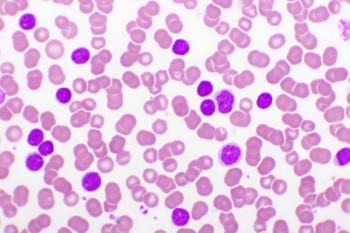
Semaglutide May Reduce Liver Fibrosis in Patients With MASH
Key Takeaways
- Semaglutide significantly improved liver fibrosis and steatohepatitis resolution in MASH patients over 72 weeks compared to placebo.
- The study involved 800 patients receiving semaglutide and 400 receiving placebo, with a notable difference in outcomes.
Weekly 2.4 mg semaglutide was linked to improved liver histology results but did not significantly reduce body pain compared with placebo.
Patients with
This is the first of 2 planned interim reports on the ESSENCE study (
Treatment with the glucagon-like peptide-1 (GLP-1) receptor agonist started with 0.25 mg weekly then escalated every 4 weeks to once-weekly doses of 0.5 mg, 1.0 mg, 1.7 mg, and 2.4 mg—adjusting as needed to respond to side effects—until patients reached the target dose of 2.4 mg, with 88% maintaining the target dose at week 72.
By that time, 62.9% of participants in the semaglutide group and in 34.3% in the placebo group experienced steatohepatitis resolution without worsening of fibrosis (estimated difference, 28.7 percentage points; 95% CI, 21.1-36.2; P < .001). This builds on previous findings of a phase 2 trial where 59% of patients taking semaglutide saw this outcome compared with 17% taking placebo (P < .001).3 Meanwhile, reduced liver fibrosis without worsening steatohepatitis was reported in 36.8% in the semaglutide arm and 22.4% in the placebo arm (estimated difference, 14.4 percentage points; 95% CI, 7.5-21.3; P < .001).1
Looking at combined benefits, a third of patients taking semaglutide were able to see both resolution of steatohepatitis and reduction of liver fibrosis (32.7%), compared with 16.1% of patients taking placebo (estimated difference, 16.5 percentage points; 95% CI, 10.2-22.8; P < .001). According to the researchers, these findings demonstrate how semaglutide can benefit patients with MASH and stage 2 or 3 liver fibrosis but warrant further and more diverse research before experts can make definitive conclusions about the drug’s impact on this patient population.
“On the basis of biologic characteristics of MASH, resolution of steatohepatitis is expected to reduce fibrogenesis—and the reduction in fibrosis stage is particularly relevant because higher stages are associated with poorer outcomes,” they said. “The demonstration of fibrosis regression in this trial, but not in the previous phase 2 study, may be due to the differences in study design, including sample size, selection of patients, pathological evaluation, and dose regimens of semaglutide.”
Regarding safety, serious adverse events—mainly gastrointestinal—occurred in 13.4% of the entire cohort, causing 2.6% of the semaglutide group and 3.3% of the placebo group to end the trial early. Additionally, 9 patients died—3 in the semaglutide group and 6 in the placebo group—though there was no evident clustering of cause of death, according to the authors.
Average bodily pain scores were not significantly different between the treatment arms. With higher scores on the 36-Item Short Form Health Survey indicating better health and less pain, the mean score increased by 0.9 points for the GLP-1 arm and decreased by –0.5 for the placebo arm (estimated difference, 1.3; 95% CI, 0.0-2.7; P = .05).
MASH is a form of liver disease where excess fat builds up in the liver and leads to inflammation. Patients with this condition frequently experience cardiometabolic comorbidities, with most patients in the current study having type 2 diabetes (55.9%) and obesity (72.8%). The latest findings also showed how the GLP-1 receptor agonist was linked to improvements in glycemic control, weight loss, and reduced insulin resistance, the last of which was seen more in patients with T2D than those without.
“These findings are important because metabolic dysfunction is an upstream event driving hepatic lipotoxicity and, subsequently, steatohepatitis and fibrogenesis,” the authors wrote. “Thus, semaglutide treatment addressed the primary pathogenic driver of MASH. The drug also provided a holistic therapeutic approach to both liver disease and associated cardiometabolic illnesses.”
Semaglutide is currently FDA-approved for multiple cardiometabolic indications. Under the brand name Ozempic, it’s approved to treat type 2 diabetes (T2D), reduce the risk of major cardiovascular events (MACE) in adults with T2D and heart disease, and reduce the risk of worsening kidney disease, kidney failure, and death from cardiovascular disease in adults with T2D and chronic kidney disease. Wegovy is approved for weight management in adults with a body mass index of 30 or higher or with at least 1 weight-related comorbidity, and to reduce the risk of MACE in adults with obesity or overweight who have established cardiovascular disease.
With resmetirom (Rezdiffra; Madrigal Pharmaceuticals, Inc.) being the only GLP-1 receptor agonist approved to treat patients with MASH and stage 2 or 3 liver fibrosis, and having only been
References
- Sanyal AJ, Newsome PN, Kliers I, et al. Phase 3 trial of semaglutide in metabolic dysfunction-associated steatohepatitis. N Engl J Med. Published online April 30, 2025. doi:10.1056/NEJMoa2413258
- Research Study on Whether Semaglutide Works in People With Non-alcoholic Steatohepatitis (NASH) (ESSENCE). https://clinicaltrials.gov/study/NCT04822181. Updated April 27, 2025. Accessed May 7, 2025.
- Newsome PN, Buchholtz K, Cusi K, et al. A placebo-controlled trial of subcutaneous semaglutide in nonalcoholic steatohepatitis. N Engl J Med. 2021;384(12):1113-1124. doi:10.1056/NEJMoa2028395
- Joszt L. FDA approves resmetirom, first treatment for NASH with liver fibrosis. AJMC®. March 14, 2024. Accessed May 7, 2025. https://www.ajmc.com/view/fda-approves-resmetirom-first-treatment-for-nash-with-liver-fibrosis
Newsletter
Stay ahead of policy, cost, and value—subscribe to AJMC for expert insights at the intersection of clinical care and health economics.









































